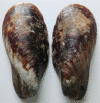Extraction, Characterization, and Antimicrobial Activity of Chitosan from Horse Mussel Modiolus modiolus
- PMID: 32832775
- PMCID: PMC7439375
- DOI: 10.1021/acsomega.0c01903
Extraction, Characterization, and Antimicrobial Activity of Chitosan from Horse Mussel Modiolus modiolus
Abstract
Chitin and chitosan have been proved to have enormous applications in biomedical, pharmaceutical, and industrial fields. The horse mussel, Modiolus modiolus, a refuse of the fishery industries at Thondi, is a reserve of rich chitin. The aim of this work is to extract chitosan from the horse mussel and its further characterization using Fourier transform infrared spectroscopy (FTIR), micro-Raman spectroscopy, X-ray diffraction (XRD), and elemental analysis. The result of FTIR studies revealed different functional groups of organic compounds such as out-of-plane bending (564 cm-1), C-O-C stretching (711 cm-1), and CH2 stretching (1174 cm-1) in chitosan. The degree of acetylation of the extracted chitosan was observed to be 57.43%, which makes it suitable as a biopolymer for biomedical applications. Prominent peaks observed with micro-Raman studies were at 484 cm-1 (14,264 counts/s), 2138 cm-1 (45,061 counts/s), and 2447 cm-1 (45,636 counts/s). XRD studies showed the crystalline nature of the polymer, and the maximum peak was observed at 20.04°. Elemental analysis showed a considerable decrease in the percentage of nitrogen and carbon upon the conversion of chitin to chitosan, while chitosan had a higher percentage of hydrogen and sulfur. The antibacterial activities of chitosan from the horse mussel were found to be efficient at a 200 μg/mL concentration against all the bacterial strains tested with a comparatively higher antibacterial activity against Escherichia coli (9 mm) and Bacillus subtilis (8 mm).
Copyright © 2020 American Chemical Society.
Conflict of interest statement
The authors declare no competing financial interest.
Figures
Similar articles
-
Extraction, characterization and antimicrobial activity of chitosan from pen shell, Pinna bicolor.Int J Biol Macromol. 2020 Nov 15;163:423-430. doi: 10.1016/j.ijbiomac.2020.06.291. Epub 2020 Jul 3. Int J Biol Macromol. 2020. PMID: 32629046
-
Potential of discarded sardine scales (Sardina pilchardus) as chitosan sources.J Air Waste Manag Assoc. 2020 Nov;70(11):1186-1197. doi: 10.1080/10962247.2020.1813840. Epub 2020 Sep 23. J Air Waste Manag Assoc. 2020. PMID: 32915095
-
Characterization of chitosan extracted from Mealworm Beetle (Tenebrio molitor, Zophobas morio) and Rhinoceros Beetle (Allomyrina dichotoma) and their antibacterial activities.Int J Biol Macromol. 2019 Mar 15;125:72-77. doi: 10.1016/j.ijbiomac.2018.11.242. Epub 2018 Nov 27. Int J Biol Macromol. 2019. PMID: 30500507
-
Extraction and physicochemical characterization of chitin and chitosan isolated from house cricket.Biomed Mater. 2018 Jan 30;13(2):025009. doi: 10.1088/1748-605X/aa9dde. Biomed Mater. 2018. PMID: 29182521
-
Antimicrobial Activity of Chemically and Biologically Treated Chitosan Prepared from Black Soldier Fly (Hermetia illucens) Pupal Shell Waste.Microorganisms. 2021 Nov 23;9(12):2417. doi: 10.3390/microorganisms9122417. Microorganisms. 2021. PMID: 34946019 Free PMC article.
Cited by
-
Boosting the Anticancer Activity of Sunitinib Malate in Breast Cancer through Lipid Polymer Hybrid Nanoparticles Approach.Polymers (Basel). 2022 Jun 16;14(12):2459. doi: 10.3390/polym14122459. Polymers (Basel). 2022. PMID: 35746034 Free PMC article.
-
Copper nanoparticles embedded fungal chitosan as a rational and sustainable bionanozyme with robust laccase activity for catalytic oxidation of phenolic pollutants.RSC Adv. 2023 Nov 1;13(46):32126-32136. doi: 10.1039/d3ra06619c. eCollection 2023 Oct 31. RSC Adv. 2023. PMID: 37920762 Free PMC article.
-
Eco-Friendly Design of Chitosan-Based Films with Biodegradable Properties as an Alternative to Low-Density Polyethylene Packaging.Polymers (Basel). 2024 Aug 30;16(17):2471. doi: 10.3390/polym16172471. Polymers (Basel). 2024. PMID: 39274104 Free PMC article.
-
Physicochemical Properties of Chitosan from Green Mussel Shells (Perna viridis): A Comparative Study.Polymers (Basel). 2023 Jun 26;15(13):2816. doi: 10.3390/polym15132816. Polymers (Basel). 2023. PMID: 37447462 Free PMC article.
-
Antimicrobial Efficiency of Chitosan and Its Methylated Derivative against Lentilactobacillus parabuchneri Biofilms.Molecules. 2022 Dec 7;27(24):8647. doi: 10.3390/molecules27248647. Molecules. 2022. PMID: 36557784 Free PMC article.
References
-
- Ngo D.-N.; Kim M.-M.; Kim S.-K. Chitin oligosaccharides inhibit oxidative stress in live cells. Carbohydr. Polym. 2008, 74, 228–234. 10.1016/j.carbpol.2008.02.005. - DOI
-
- Rinaudo M. Chitin and chitosan: Properties and applications. Prog. Polym. Sci. 2006, 31, 603–632. 10.1016/j.progpolymsci.2006.06.001. - DOI
-
- Arvanitoyannis I. S.; Nakayama A.; Aiba S.-i. Chitosan and gelatin based edible films: State diagrams, mechanical and permeation properties. Carbohydr. Polym. 1998, 37, 371–382. 10.1016/s0144-8617(98)00083-6. - DOI
LinkOut - more resources
Full Text Sources





